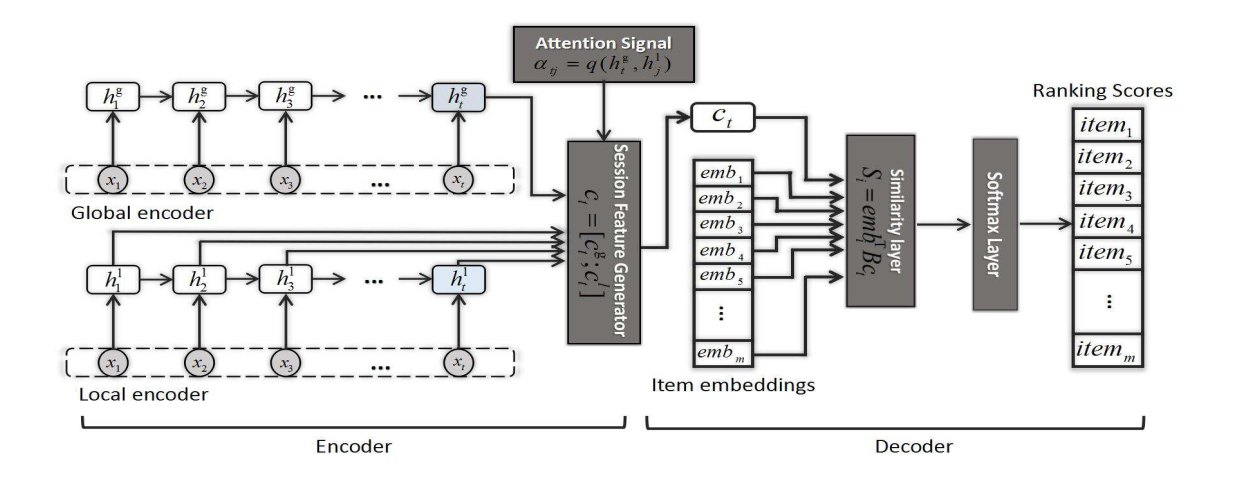NARM¶
Introduction¶
Title: Neural Attentive Session-based Recommendation
Authors: Jing Li, Pengjie Ren, Zhumin Chen, Zhaochun Ren, Tao Lian, Jun Ma
Abstract: Given e-commerce scenarios that user profiles are invisible, sessionbased recommendation is proposed to generate recommendation results from short sessions. Previous work only considers the user’s sequential behavior in the current session, whereas the user’s main purpose in the current session is not emphasized. In this paper, we propose a novel neural networks framework, i.e., Neural Attentive Recommendation Machine (NARM), to tackle this problem. Specifically, we explore a hybrid encoder with an attention mechanism to model the user’s sequential behavior and capture the user’s main purpose in the current session, which are combined as a unified session representation later. We then compute the recommendation scores for each candidate item with a bi-linear matching scheme based on this unified session representation. We train NARM by jointly learning the item and session representations as well as their matchings. We carried out extensive experiments on two benchmark datasets. Our experimental results show that NARM outperforms state-of-the-art baselines on both datasets. Furthermore, we also find that NARM achieves a significant improvement on long sessions, which demonstrates its advantages in modeling the user’s sequential behavior and main purpose simultaneously.

Running with RecBole¶
Model Hyper-Parameters:
embedding_size (int): The embedding size of items. Defaults to64.hidden_size (int): The number of features in the hidden state. Defaults to128.n_layers (int): The number of layers in GRU. Defaults to1.dropout_probs (list of float): The dropout rate, there are two values, the former is for embedding layer and the latter is for concatenation of the vector obtained by the local encoder and the vector obtained by the global encoder. Defaults to[0.25,0.5].loss_type (str): The type of loss function. If it set to'CE', the training task is regarded as a multi-classification task and the target item is the ground truth. In this way, negative sampling is not needed. If it set to'BPR', the training task will be optimized in the pair-wise way, which maximize the difference between positive item and negative item. In this way, negative sampling is necessary, such as settingtraining_neg_sample_num = 1. Defaults to'CE'. Range in['BPR', 'CE'].
A Running Example:
Write the following code to a python file, such as run.py
from recbole.quick_start import run_recbole
run_recbole(model='NARM', dataset='ml-100k')
And then:
python run.py
Tuning Hyper Parameters¶
If you want to use HyperTuning to tune hyper parameters of this model, you can copy the following settings and name it as hyper.test.
learning_rate choice [0.01,0.005,0.001,0.0005,0.0001]
hidden_size choice [128]
n_layers choice [1,2]
dropout_probs choice ['[0.25,0.5]','[0.2,0.2]','[0.1,0.2]']
Note that we just provide these hyper parameter ranges for reference only, and we can not guarantee that they are the optimal range of this model.
Then, with the source code of RecBole (you can download it from GitHub), you can run the run_hyper.py to tuning:
python run_hyper.py --model=[model_name] --dataset=[dataset_name] --config_files=[config_files_path] --params_file=hyper.test
For more details about Parameter Tuning, refer to Parameter Tuning.
If you want to change parameters, dataset or evaluation settings, take a look at